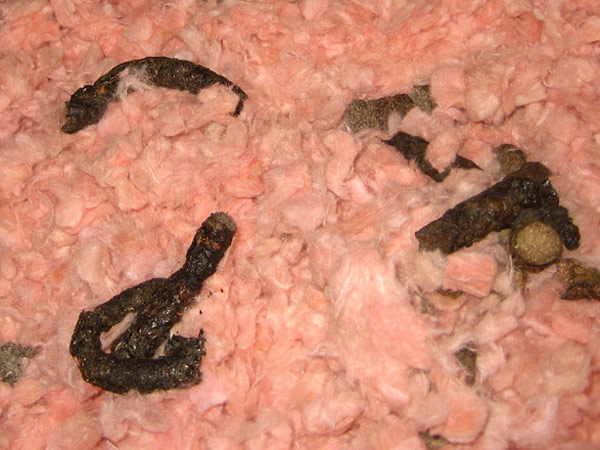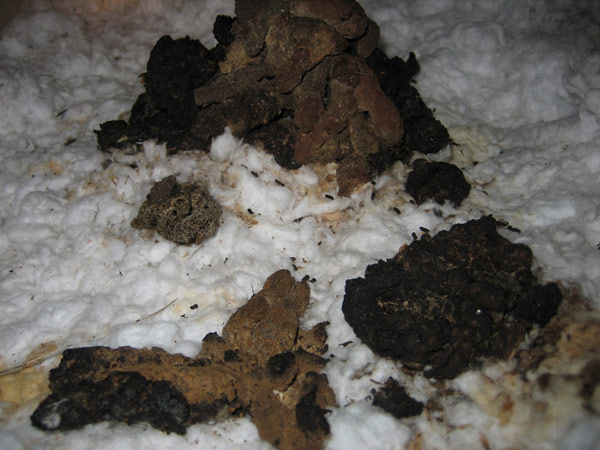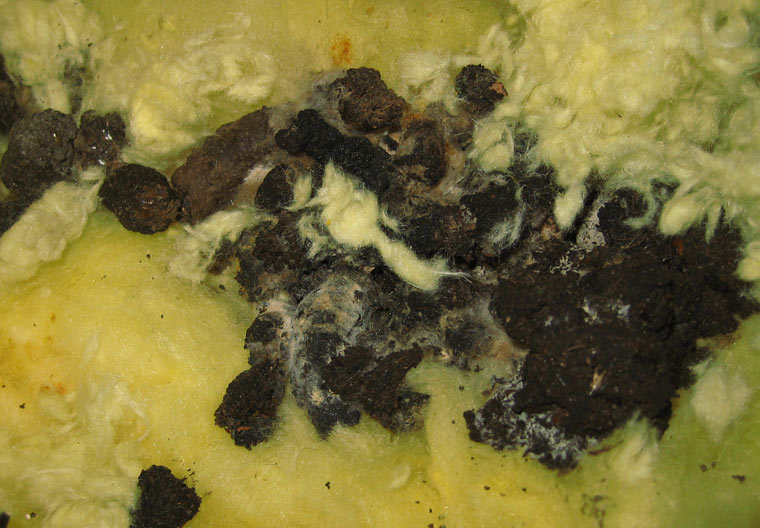- info@wildlife-removal.com
Call us for help in your town
Wildlife Removal Education
Photographs of Raccoon Poop
The below photos should help you properly identify the animal poop that you see. These are pictures of raccoon poop. If you see these types droppings in
your attic or yard, they were made by a raccoon. Please DO NOT TOUCH RACCOON FECES. It can contain raccoon roundworm, which can infect people, and cause
blindness and other terrible symptoms. Call your local pro and you will get free advice about how to handle and clean raccoon droppings.
NEED HELP? EMAIL ME! poop@wildlife-removal.com
Email me a photo of the animal feces you found, and I'll tell you which critter made it!
Need raccoon removal in your hometown? We service over 500 USA locations! Click here to hire us in your town and check prices - updated for year 2025.
RACCOON POOP DESCRIPTION: Fairly large, like dog poo. Averages 3/4 inch in diameter. The sides are usually textured, and the tips are often rounded or broken off. The surefire giveaway is if there are berries
in the poop. Raccoon feces commonly have berries, so if you see them, it's definitely raccoon.

The above image of raccoon feces was photographed in the attic of a house with a raccoon problem. I was able to identify the type of animal by inspecting the turds. Once I know what type of critter is in the house or
the crawlspace, ceiling, yard, or any other part of the property, I can take the proper steps to get rid of the unwanted wildlife.
Does raccoon poop cause any health risk or disease concerns? Yes. Raccoon Roundworm in both people and pets is caused by contact with infected raccoon feces, which can pass the eggs to humans. Contracting this disease
occurs by ingestion or even inhalation of the eggs. Infection of humans can lead to larval parasites, which affect the central nervous system. In addition to roundworm, Giardia lamblia is a protozoan causing diarrhea, and
is caused by ingesting food or water contaminated by raccoon excrement. Raccoon Roundworm — What is it?

The above picture is part of a raccoon latrine - lots of feces and pee. I have more pics of raccoon poop here on my website, or I can send some more to you if you write to me. I don't think anyone else out there has as many images of raccoon poop and droppings as me - I often take photos of animal
droppings to show the customer what kind of animal they have, and so that they can decide if they need me to clean up the raccoon waste, the scat and urine, and decontaminate. If you need to know how to identify raccoon poop, pictures
such as the ones above are the best bet, but you can take a photograph and send it to me, and I'll tell you what kind of animal droppings you have.
How do I clean up the raccoon latrine? You must remove the feces by hand, including any soiled and dirty insulation and bag it in plastic bags. Be sure to wear gloves and a HEPA respirator mask, and even a Tyvek suit. I then spray / fog the area
with a special enzyme cleaner, but any good disinfectant will suffice for some of it. To kill raccoon roundworm, you need a special cleaner. Read more info on my: attic cleanup and restoration page.
Customer email about raccoon poo:
Hello, Thank you for all the work you have put into informing the public about animals in the wrong places. I am in the tree service business and have minimal experience with live trapping. We bought our house in 1991 and at the time,
the home was vacant for 3 years. We are in Grosse Pointe, Michigan and are near a large, old wooded golf coarse. When we got the house, it had many problems, one was infestation. Ants, mice, and Raccoons. The attic was absolutely
full of raccoon shit, and mouse crap too. The elderly women that owned the house fed the birds (religiously) and boarded cats and dogs for people. I found four inches of rotten bird feed in the sub floor in the garage storage closets. The exterminator
(at the time) said "It was the largest population of mice in a devilling I have ever encountered". We had a raccoon in the attic and it was finally eliminated (live trapped and relocated). The house (a one story ranch) had screened
in air vents (under the overhangs) that I put a double layer of 1/4" hardware cloth over and new moldings that proved to discourage entry. Since then, no problems until 3 years ago, when I found them under our deck, nesting inside a window
well. The female had pups and we watched them age (through the glass in the basement). When fall came, and they went to make their own way, I put a few moth balls out and closed off the entry way and thought, problem solved. Last month
while pruning a tree, I found (on the other side of the house) an entry way in the overhang air vent (that was never re-enforced with the hardware cloth upgrade......dumbass). My eleven year old daughters' bedroom is right under that part
of the attic and we here the goings on at dawn and dusk. This house has a very low angle roof line and almost a flat roof (Frank Lloyd Wright style). The attic is more a belly crawl space and really complicated the last removal efforts. I
don't think I can reach the raccoon latrine. In
the north, when do you think the cubs will be moving on? I have a nice, big, Havahart live trap. Jim
My response: Raccoon cubs move on in 6 months, but I'd try to get them out sooner, by manual removal, because you don't want that racoon feces building up in your attic.
I've also written a page about raccoon urine, which also contaminates attic spaces, and can promote wood rot.
How to Get Rid of Raccoon Skat Left in the Attic
Skat is the name given to raccoon poop, and it's poop that you may even have encountered in your own back yard without even knowing it. Believe it or not, the poop of a raccoon looks very much like the poop of a cat or small dog. Those poor domestic animals have long since been taking the blame for droppings left by wild passing scavengers, but it's time to put the record straight.

Raccoon poop usually has a bit more in the way of remnants left in the poop, helping you to work out whether or not it is a raccoon or another animal, such as a cat or dog, leaving it. If the poop is in the attic, there's a very slight chance that your dog or another dog in the neighborhood has managed to get up there, but a cat can occasionally master the feat. If the feces has berries or other food remnants in it, there's a good chance it is raccoon skat.
Raccoon Skat is Dangerous
Before we continue, we feel that it is our duty to inform you of the dangers of working closely alongside raccoon droppings, such as when you are cleaning it up. Although the animal will usually do you a favor, leaving all droppings and waste in a latrine area and, therefore, concentrated to just one patch, the dangers associated with it make it something you just wouldn't want to clean up yourself.
Clearing up raccoon skat requires as much protective gear as you can get your hands on - a face mask, thick gloves, eye protection, and even a protective suit if you can get one. Everything you use to clean up the mess should be disposed of too. Throw the old bucket and sponges out and treat yourself to new ones. The old ones are contaminated now.
Cleaning Raccoon Skat is Actually Time Critical
Raccoons are responsible for the spread of one of their namesakes - raccoon roundworm. This delightful little parasite has eggs laid in the feces of raccoons, and about two to four weeks after the eggs were laid, they start to become problematic. If you can get to the feces and clean it up properly within the first two to four weeks, the chances of you encountering the infective eggs of raccoon roundworm are reduced.
Indoor Cleaning & Outdoor Cleaning = Slightly Different
When you're working in the great outdoors - an outside latrine - you are working in a well-ventilated area. When you're cleaning raccoon droppings out of your attic, you are NOT in a well-ventilated space. This changes the products you can safely use and how long you can safely confine yourself to the small space that is your attic.
The dust and remnants of raccoon poop can turn dry and dusty when they have been there for some time, and the tiny disease spores can then be sent airborne, particularly when they are swept about. We do not recommend that you attempt to clean up dry and dusty raccoon skat, first spraying it lightly with some water, perhaps mixed with antibacterial essential oils. When it is moist, the particles are heavier and, therefore, less likely to be scattered around in the air.
Wearing your protective clothing, including gloves, full body suit, boot coveralls, eye protection, and a breathing or face mask, you should put all debris and droppings into a bag that will be sealed when full, and then disposed of in the correct manner. It can be buried, although you are running the risk of another wild animal digging up the remains, you can also burn the material, or multi-trash-bag it. The best option here is to burn the material. You can make one hundred percent sure that it has all been disposed of correctly. We recommend that you continue to wear the breathing or face mask whilst in the vicinity of the burning material.
Any areas that have been in contact with potentially contaminated material should be wiped down, but not with a really wet cloth or sponge; with one that is slightly damp. Again, the water spray might come in handy here. Once all dirty bits are gone, you can start to use cleaning products that will then disinfect the area and take away any remaining disease threats. A strong disinfectant is a good place to start, although, you must remember not to mix cleaning products and to always read the label. Certain products are not suited to small and enclosed spaces, and when two or more cleaning products are mixed together, they have the potential to react, causing a potentially dangerous situation for you.
In layers, you will want to use antibacterial, anti-fungal, and disinfectant cleaning products, using as much of your strength as you can muster to give the entire area a really good scrub down. This isn't the kind of job to graze over, because any material, no matter how small, left behind has the potential to spread disease to you, the rest of your family or household, and also to any pets or other wild critters that are nearby.
There are NO known chemicals or cleaning products that kill off roundworm eggs, so this is a job that you will want to do to the very best of your ability, or leave it down to the professionals.
Go back to the Raccoon Removal page, or learn tips to do it yourself with my How to Get Rid of Raccoons guide.


















